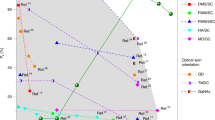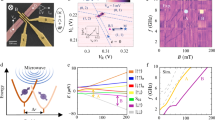Abstract
The processing of quantum information based on the electron spin degree of freedom1,2 requires fast and coherent manipulation of local spins. One approach is to provide spatially selective tuning of the spin splitting—which depends on the g-factor—by using magnetic fields3, but this requires their precise control at reduced length scales. Alternative proposals employ electrical gating1 and spin engineering in semiconductor heterostructures involving materials with different g-factors. Here we show that spin coherence can be controlled in a specially designed AlxGa1-xAs quantum well in which the Al concentration x is gradually varied across the structure. Application of an electric field leads to a displacement of the electron wavefunction within the quantum well, and because the electron g-factor varies strongly with x, the spin splitting is therefore also changed. Using time-resolved optical techniques, we demonstrate gate-voltage-mediated control of coherent spin precession over a 13-GHz frequency range in a fixed magnetic field of 6 T, including complete suppression of precession, reversal of the sign of g, and operation up to room temperature.
This is a preview of subscription content, access via your institution
Access options
Subscribe to this journal
Receive 51 print issues and online access
$199.00 per year
only $3.90 per issue
Buy this article
- Purchase on Springer Link
- Instant access to full article PDF
Prices may be subject to local taxes which are calculated during checkout




Similar content being viewed by others
References
Loss, D. & DiVincenzo, D. P. Quantum computation with quantum dots. Phys. Rev. A 57, 120–126 (1998).
Kane, B. E. A silicon-based nuclear spin quantum computer. Nature 393, 133–137 (1998).
DiVincento, D. P. et al. Quantum computing and single qubit measurements using the spin filter effect. J. Appl. Phys. 85, 4785–4787 (1999).
Snelling, M. J. et al. Magnetic g-factor of electrons in GaAs/AlxGa1-xAs quantum wells. Phys. Rev. B 44, 11345–11352 (1991).
Kowalski, B. et al. Conduction-band spin splitting of type-I GaxIn1-xAs/InP quantum wells. Phys. Rev. B 49, 14786–14789 (1994).
Ivchenko, E L., Kiselev, A. A. & Willander, M. Electronic g-factor in biased quantum wells. Solid State Commun. 102, 375–378 (1997).
Jiang, H. W. & Yablonovitch, E. Gate-controlled electron spin resonance in GaAs/AlxGa1-xAs heterostructures. Phys. Rev. B 64, R41307–41310 (2001).
Salis, G. et al. Wave function spectroscopy in quantum wells with tunable electron density. Phys. Rev. Lett. 79, 5106–5109 (1997).
Weisbuch, C. & Hermann, C. Optical detection of conduction-electron spin resonance in GaAs, Ga1-xInxAs, and Ga1-xAlxAs. Phys. Rev. B 15, 816–822 (1977).
Gossard, A. C. Growth of microstructures by molecular beam epitaxy. IEEE J. Quant. Electr. 22, 1649–1655 (1986).
Maranowski, K. D., Ibbetson, J. P., Campman, K. L. & Gossard, A. C. Interface between low-temperature grown GaAs and undoped GaAs as a conduction barrier for back gates. Appl. Phys. Lett. 66, 3459–3461 (1995).
Kikkawa, J. M., Smorchkova, I. P., Samarth, N. & Awschalom, D. D. Room-temperature spin memory in two-dimensional electron gases. Science 277, 1284–1287 (1997).
Amand, T. et al. Spin quantum beats of 2D excitons. Phys. Rev. Lett. 78, 1355–1358 (1997).
Miller, D. A. B. et al. Band-edge electroabsorption in quantum well structures: the quantum-confined Stark effect. Phys. Rev. Lett. 53, 2173–2176 (1984).
Miller, R. C., Gossard, A. C. & Kleinmann, D. A. Band offsets from two special GaAs-AlxGa1-xAs quantum-well structures. Phys. Rev. B 32, 5443–5446 (1985).
Chu-liang, Y. & Qing, Y. Sublevels and excitons in GaAs-AlxGa1-xAs parabolic-quantum-well structures. Phys. Rev. B 37, 1364–1367 (1988).
Oestreich, M. & Rühle, W. W. Temperature dependence of the electron Lande g-factor in GaAs. Phys. Rev. Lett. 74, 2315–2318 (1995).
Bir, G. L., Aronov, A. G. & Pikus, G. E. Spin relaxation of electrons scattered by holes. Sov. Phys. JETP 42, 705–712 (1976).
Paillard, M. et al. Spin relaxation quenching in semiconductor quantum dots. Phys. Rev. Lett. 86, 1634–1637 (2001).
De Poortere, E. P., Tutuc, E., Papadakis, S. J. & Shayegan, M. Resistance spikes at transitions between quantum Hall ferromagnets. Science 290, 1546–1549 (2000).
Acknowledgements
We thank J. Kotthaus, M. E. Flatté, I. Meinel and R. K. Kawakami for discussions. This work was supported by DARPA, ONR and NSF.
Author information
Authors and Affiliations
Corresponding author
Rights and permissions
About this article
Cite this article
Salis, G., Kato, Y., Ensslin, K. et al. Electrical control of spin coherence in semiconductor nanostructures. Nature 414, 619–622 (2001). https://doi.org/10.1038/414619a
Received:
Accepted:
Issue Date:
DOI: https://doi.org/10.1038/414619a
This article is cited by
-
Electric field-tuneable crossing of hole Zeeman splitting and orbital gaps in compressively strained germanium semiconductor on silicon
Communications Materials (2023)
-
Optimal operation points for ultrafast, highly coherent Ge hole spin-orbit qubits
npj Quantum Information (2021)
-
Spin transport in polarization induced two-dimensional electron gas channel in c-GaN nano-wedges
Scientific Reports (2021)
-
Quantized conductance in a one-dimensional ballistic oxide nanodevice
Nature Electronics (2020)
-
Electrically tunable effective g-factor of a single hole in a lateral GaAs/AlGaAs quantum dot
Communications Physics (2019)
Comments
By submitting a comment you agree to abide by our Terms and Community Guidelines. If you find something abusive or that does not comply with our terms or guidelines please flag it as inappropriate.



